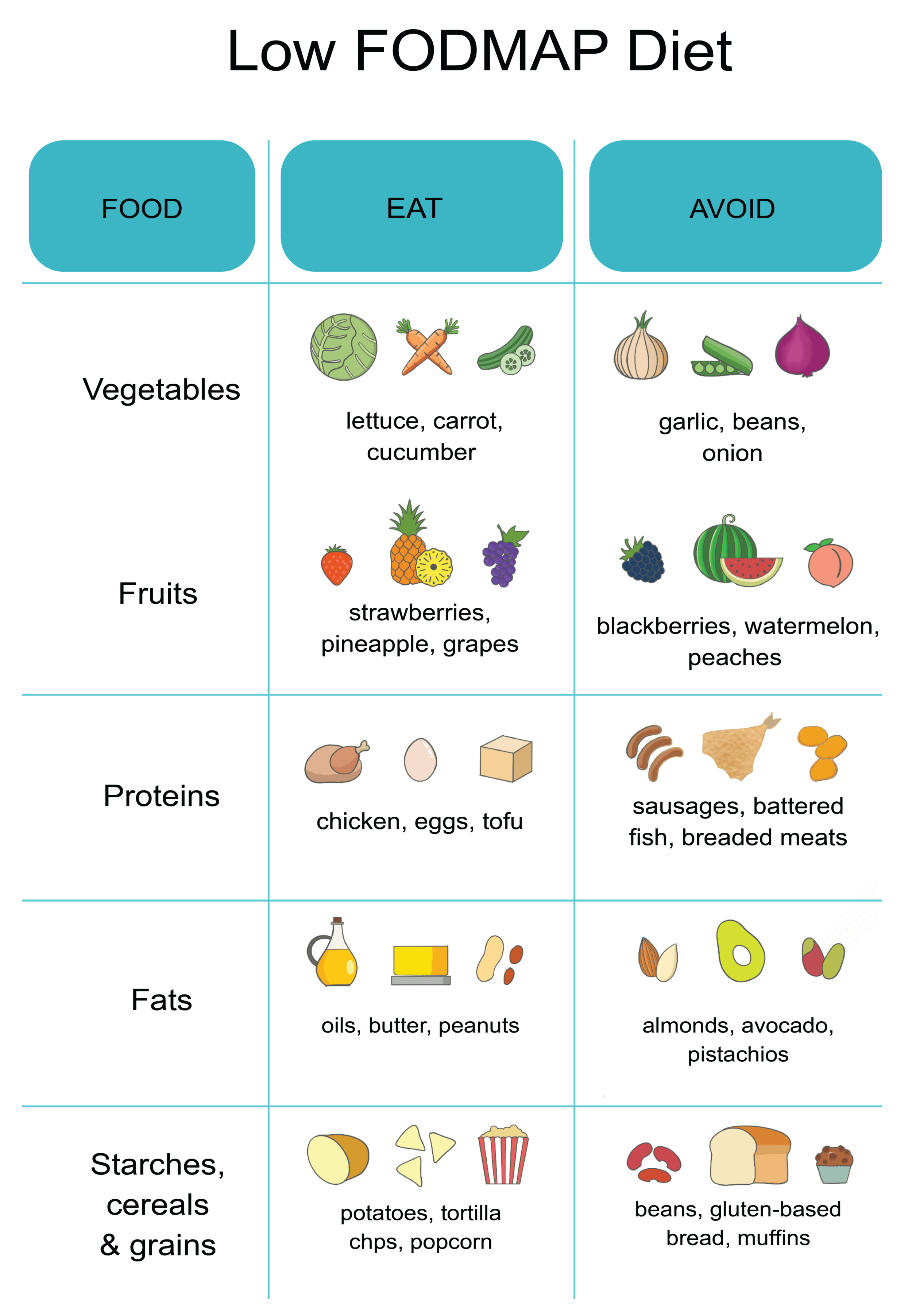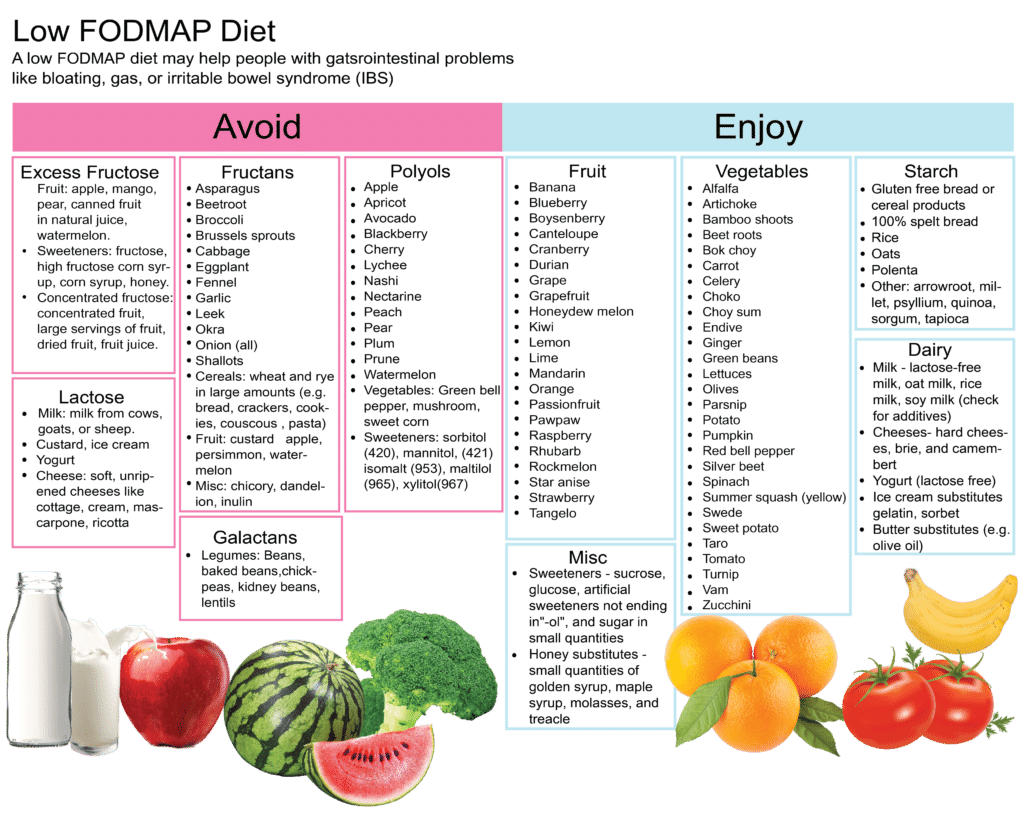A low FODMAP diet is a dietary approach that helps to reduce the intake of certain types of carbohydrates that can cause digestive symptoms in some people. FODMAP stands for "Fermentable Oligo-, Di-, Mono-saccharides And Polyols," which are types of short-chain carbohydrates that are poorly absorbed in the small intestine and can cause symptoms such as bloating, gas, abdominal pain, and diarrhea in people with irritable bowel syndrome (IBS) or other digestive disorders.
If you have irritable bowel syndrome (IBS) or another digestive issue, you may benefit from following a low FODMAP diet. This involves avoiding high FODMAP foods, which can be difficult to digest and can cause symptoms such as bloating, gas, and abdominal pain.
Foods to Avoid
You will need to avoid foods that are high in FODMAPs, such as certain types of fruits, vegetables, grains, and dairy products. Some examples of high FODMAP foods include:
Fruits: Apples, apricots, blackberries, cherries, mango, nectarines, peaches, pears, plums, watermelon.
Vegetables: Artichokes, asparagus, beets, broccoli, Brussels sprouts, cabbage, cauliflower, garlic, leeks, mushrooms, onions, peas, shallots, beans (e.g., kidney beans, lentils, chickpeas).
Dairy: Cow's milk, goat's milk, ice cream, yogurt.
Grains: Barley, bran, rye, wheat.
Nuts and seeds: Cashews, pistachios.
Sweeteners: High fructose corn syrup, honey.
Other: Alcohol (especially beer and cocktails), chocolate, coffee, fructose, fructooligosaccharides (FOS), fruit juice, inulin, lactose, pectin, processed meats (e.g., hot dogs, salami, deli meats), sauces and condiments (e.g., barbecue sauce, tomato sauce).
Foods to Eat
If you're following a low FODMAP diet, it can be helpful to have a list of foods that you can eat. Focus on consuming low FODMAP foods, such as:
Fruits: Apple, banana, blueberries, grapes, lemon, kiwifruit, melon, oranges, papaya, raspberries, strawberries, watermelon.
Vegetables: Arugula, carrots, cauliflower, cucumber, eggplant, green beans, leafy greens (e.g., spinach, kale), lettuce, mushrooms, onions, parsnips, peas, potatoes, pumpkin, radishes, squash, tomatoes, turnips, zucchini.
Proteins: Beef, chicken, fish, pork, shellfish, tofu, turkey, veal.
Grains: Oats, rice.
Nuts and seeds: Almond butter, peanut butter, sunflower seeds.
Dairy alternatives: Almond milk.
Other: Chives, egg whites, olive oil, scallions, sweet potato, potato.
This list should give you a good starting point for building meals that are low in FODMAPs. Remember to also pay attention to portion sizes, as even low FODMAP foods can cause digestive issues if consumed in large quantities.


Recipes
Here are a few low FODMAP recipes to try.
Breakfast
- Overnight Oats: In a jar or container, mix together 1/2 cup of rolled oats, 1/2 cup of almond milk, 1/2 cup of low FODMAP fruit (such as strawberries, blueberries, or raspberries), and a few tablespoons of chia seeds. Stir everything together and refrigerate overnight. In the morning, top the oats with some chopped nuts or seeds, and a drizzle of honey or maple syrup if desired.
- Avocado Toast: Toast a slice of low FODMAP bread until it is crispy. Mash half an avocado and spread it on top of the toast. Top with a few slices of tomato, a sprinkle of salt and pepper, and a drizzle of olive oil. You can also add some hard cheese or a fried egg for extra protein.
- Egg and Vegetable Scramble: Heat a tablespoon of oil in a pan over medium heat. Add in some low FODMAP vegetables such as bell peppers, mushrooms, and spinach, and sauté until they are tender. Beat 2-3 eggs in a small bowl, then pour them into the pan with the vegetables. Scramble the eggs until they are cooked to your liking. Serve the scramble with a slice of low FODMAP toast or a small side of fruit.
Lunch and Dinner
- Roasted Chicken and Vegetables: Preheat your oven to 400°F. Cut up some vegetables such as carrots, bell peppers, and sweet potatoes into small pieces. Place them on a baking sheet and toss with olive oil, salt, and pepper. Roast for 20-25 minutes, or until the vegetables are tender. Meanwhile, season a chicken breast with your choice of spices and bake it in a separate dish for 25-30 minutes, or until cooked through. Serve the chicken and vegetables together for a simple and satisfying meal.
- Quinoa and Black Bean Salad: Cook 1 cup of quinoa according to the package instructions. Drain and rinse a can of black beans, and mix them together with the cooked quinoa. Add in some diced tomatoes, bell peppers, and cucumbers. For the dressing, whisk together 2 tablespoons of olive oil, 1 tablespoon of lemon juice, and some salt and pepper. Toss the salad with the dressing and serve.
- Grilled Salmon and Steamed Broccoli: Preheat your grill to medium-high heat. Season a salmon fillet with your choice of spices and grill for 6-8 minutes per side, or until cooked through. Steam some broccoli florets until they are tender. Serve the grilled salmon and steamed broccoli together for a healthy and flavorful meal.
- Vegetable Soup: Heat a tablespoon of olive oil in a large pot over medium heat. Add in some low FODMAP vegetables such as carrots, bell peppers, and zucchini, and sauté for 5-7 minutes, or until tender. Add in a can of diced tomatoes, 4 cups of low FODMAP broth, and some herbs and spices of your choice. Bring the soup to a boil, then reduce the heat and simmer for 15-20 minutes. Serve the soup with a side of low FODMAP bread or crackers.
- Tofu Stir-Fry: Press and drain some tofu, then cut it into small cubes. Heat a tablespoon of oil in a large pan over medium-high heat. Add the tofu and stir-fry for 5-7 minutes, or until it is golden brown. Remove the tofu from the pan and set it aside. In the same pan, stir-fry some low FODMAP vegetables such as bell peppers, broccoli, and carrot for 5-7 minutes, or until tender. Stir in the tofu, along with your choice of sauce (such as soy sauce or hoisin sauce). Serve the stir-fry over rice or noodles.
- Grilled Eggplant and Zucchini: Preheat your grill to medium-high heat. Slice an eggplant and a zucchini into thin rounds. Brush both sides with olive oil and sprinkle with salt and pepper. Grill the eggplant and zucchini for 4-6 minutes per side, or until tender. Serve the grilled vegetables with a side of low FODMAP pasta or grains.
- Chickpea Salad: Drain and rinse a can of chickpeas, then toss them with some diced tomatoes, cucumbers, bell peppers, and parsley. For the dressing, whisk together 2 tablespoons of olive oil, 1 tablespoon of lemon juice, and some salt and pepper. Toss the salad with the dressing and serve. You can also add in some hard cheese or grilled chicken for a protein boost.
Dessert
Here are some low FODMAP dessert options
- Chocolate avocado mousse: Mash one ripe avocado and mix it with 1/4 cup cocoa powder, 2 tablespoons honey, and 1/2 cup almond milk until smooth. Refrigerate for at least an hour before serving.
- Banana ice cream: Cut three ripe bananas into slices and freeze them on a baking sheet. Once frozen, blend the banana slices in a food processor or high-speed blender until smooth. Serve immediately or freeze in an airtight container for up to a week.
- Low FODMAP fruit salad: Chop up a variety of low FODMAP fruits, such as berries, citrus fruits, and kiwi, and mix them together in a bowl. Serve chilled or at room temperature.
- Low FODMAP brownies: Mix together 1 cup almond flour, 1/2 cup cocoa powder, 1/4 cup honey, 1/4 cup melted coconut oil, 1 egg, and 1 teaspoon vanilla extract until well combined. Pour the mixture into a greased 8x8 inch baking dish and bake at 350°F for 20-25 minutes.
- Low FODMAP chocolate chip cookies: In a large bowl, cream together 1/2 cup butter, 1/4 cup sugar, and 1/4 cup brown sugar until smooth. Beat in 1 egg and 1 teaspoon vanilla extract. In a separate bowl, mix together 1 1/2 cups almond flour, 1/4 teaspoon baking soda, and 1/4 teaspoon salt. Gradually add the dry ingredients to the wet ingredients and mix until well combined. Stir in 1/2 cup chocolate chips. Drop spoonfuls of the dough onto a greased baking sheet and bake at 350°F for 8-10 minutes.
Frequently Asked Questions
A low FODMAP diet is typically followed for a period of 4-6 weeks. During this time, you will need to strictly avoid high FODMAP foods and focus on consuming low FODMAP foods. After this initial period, you can start to slowly reintroduce high FODMAP foods back into your diet to see how your body tolerates them. This process is called the "rechallenge phase," and it is important for identifying your specific trigger foods and determining which FODMAPs you can tolerate in larger amounts.
A low FODMAP diet should only be followed under the guidance of a healthcare professional, such as a registered dietitian or a doctor who is experienced in managing digestive disorders. It is important to note that a low FODMAP diet can be low in certain nutrients, such as fiber, if not properly planned. It is also important to get enough variety in your diet to ensure that you are getting all of the nutrients that your body needs.
Not all fruits and vegetables are high in FODMAPs, so it is possible to include some of them in your diet. Some low FODMAP options include bananas, oranges, strawberries, kiwifruit, grapes, melon, pineapple, raspberries, blueberries, carrot, sweet potato, pumpkin, potato, lettuce, tomato, bell peppers, cucumber, and eggplant.
Yes, there are some grains that are low in FODMAPs and can be included in a low FODMAP diet. These include rice, quinoa, corn, polenta, and pasta made from corn or rice. You should avoid wheat, rye, barley, and spelt, as well as oats (except for small amounts of oats that are well-tolerated).
Some dairy products are high in FODMAPs and should be avoided on a low FODMAP diet, including cow's milk, yogurt, ice cream, soft cheese, and ricotta. However, you can still include hard cheese and lactose-free dairy products in your diet. Non-dairy alternatives such as almond milk and coconut milk are also low in FODMAPs and can be included.
Yes, there are many plant-based protein sources that are low in FODMAPs and can be included in a low FODMAP diet. Some options include tofu, tempeh, and legumes such as lentils and chickpeas (when consumed in small amounts). It's important to rinse and drain canned legumes to remove some of the FODMAPs, and to cook dried legumes in plenty of water to help reduce the FODMAP content.

